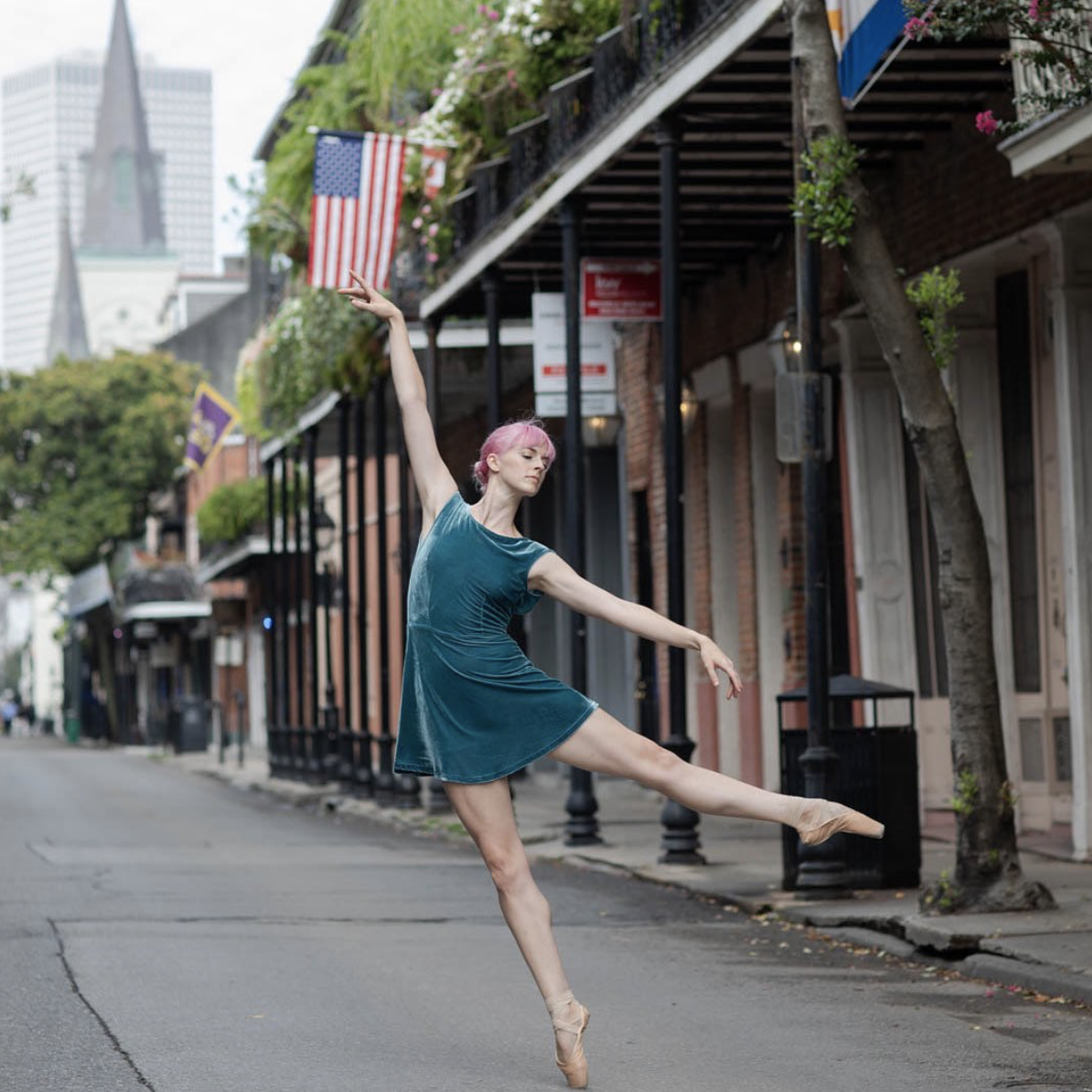Read Sarah Fox’s Introduction for “One Year Later” to see why she’s pulling together these specific articles in the series.

Felicia McPhee stopping French Quarter traffic while moving through a la seconde en pointe. (Photo by: Ashkan Roayaee)
Editor’s Note: The following series “One Year Later” is a week-long series curated by Sarah Fox as part of the Digital Research Internship Program in partnership with ViaNolaVie. The DRI Program is a Newcomb Institute technology initiative for undergraduate students combining technology skillsets, feminist leadership, and the digital humanities.
As we enter March in 2021, many of us can’t help but feel like we haven’t even processed the events of last March. The COVID-19 pandemic quickly went from a small news story thousands of miles away to up close and personal as we packed our offices, dorms and apartments to move inside. Marking the one-year anniversary, “One Year Later” is not meant to further highlight things we miss or how our lives have been negatively affected, but to demonstrate the resilience of human nature and how we’ve adapted to extraordinary circumstances.
This articles details how the New Orleans Ballet Company adapted to a performance season cut short and how company member Felicia McPhee rose took to Instagram to perform. This article was originally published on ViaNolaVie on June 26, 2020.
With a quick confirmation for valid Internet connection, aspiring ballet dancers from around the world begin to flood in — eager to learn this Wednesday’s carefully curated ballet routine. Today, the New Orleans Ballet Theatre’s Instagram will host Felicia McPhee’s weekly live-streamed ballet master class. From the confines of her living room, McPhee’s legs stretch into a plié while concurrently avoiding hitting her snoozing dog, who is sprawled across the floor.
This is the new normal for Felicia McPhee amid the coronavirus crisis that first plagued New Orleans in mid-March. As a dancer with the New Orleans Ballet Theatre, McPhee would typically be expected to participate in four to five ballet performances per year with the company, not including additional promotional galas, fundraisers, festivals and isolated freelance work. However, all of that potential for a typical ballet season fell apart at the seams when the coronavirus gained prevalence in New Orleans.
“When the quarantine hit, we were preparing for our March show,” McPhee said. “We heard that San Francisco Ballet canceled their season, but we were like, ‘Our show’s in two weeks. There’s just no way we’re not going to do our show.’ Then everyone started quarantining the day that we were rehearsing full out. The next day, our show was canceled. It was just over.”
Though the virus prevented the company from performing for large audiences onstage, the flexibility synonymous with ballet dancers was exhibited in the company’s ability to continue to entertain and educate the public even when traditional performances were no longer permissible. McPhee recalls, “It was such a hard hit because it’s not just a job, it’s our passion for life. It’s what we’ve chosen to do with our lives. We try to keep up our technique with ballet barre Zoom classes taught by ballet masters, but it’s very hard to practice at home.”
Just twelve days after the New Orleans Ballet Theatre announced that all upcoming performances were postponed due to COVID-19, the theatre began producing Instagram live-streamed ballet classes taught by various company members, including Felicia McPhee. Despite her pride in her company’s versatility to maintain a virtual presence, McPhee still holds out hope that all will eventually return to normal once the residual effects of coronavirus subside.
“Ballet has remained part of our culture because it speaks to us in a different way,” McPhee said. “You can portray what you want to say to an audience no matter what language you speak or what your past experiences are. That’s what’s great about having this online presence now. We’re still able to get our stories and voices across to the whole world.”
This piece is part of the on-going series “Creative Labor Through the Crisis,” which is part of a Creative Labor course at Tulane University taught by Dr. Vicki Mayer and Kelley Crawford.
 NOLAbeings Multimedia artist Claire Bangser created NOLAbeings as a portrait-based story project that marries...
NOLAbeings Multimedia artist Claire Bangser created NOLAbeings as a portrait-based story project that marries...  Voodoo in New Orleans: Reviving history: New Orleans fortune telling This article takes a deep dive into the history of Voodoo in New Orleans, its hybridization with Catholicism, and its present-day place in the city's culture. The author visits fortune-tellers in the French Quarter, using their guidance as a tool for introspection rather than a deterministic predictor of the future. Through her experiences in New Orleans, the author feels a mystical connection to both the past and the future.
Voodoo in New Orleans: Reviving history: New Orleans fortune telling This article takes a deep dive into the history of Voodoo in New Orleans, its hybridization with Catholicism, and its present-day place in the city's culture. The author visits fortune-tellers in the French Quarter, using their guidance as a tool for introspection rather than a deterministic predictor of the future. Through her experiences in New Orleans, the author feels a mystical connection to both the past and the future. 